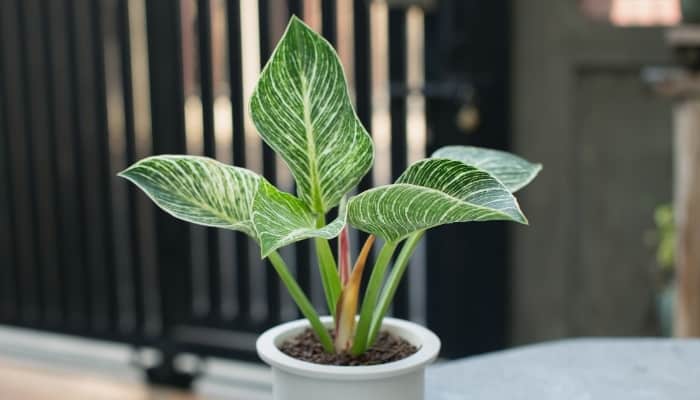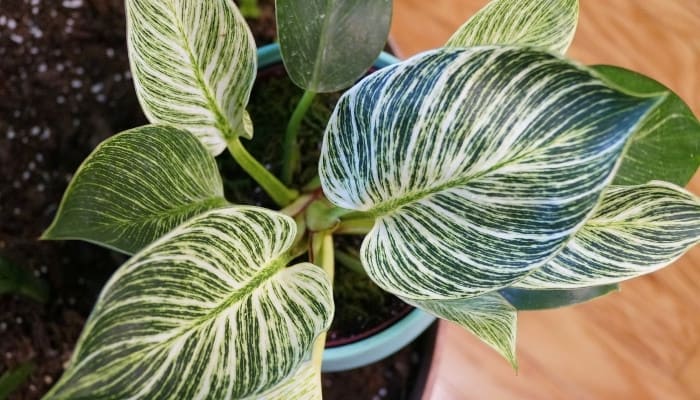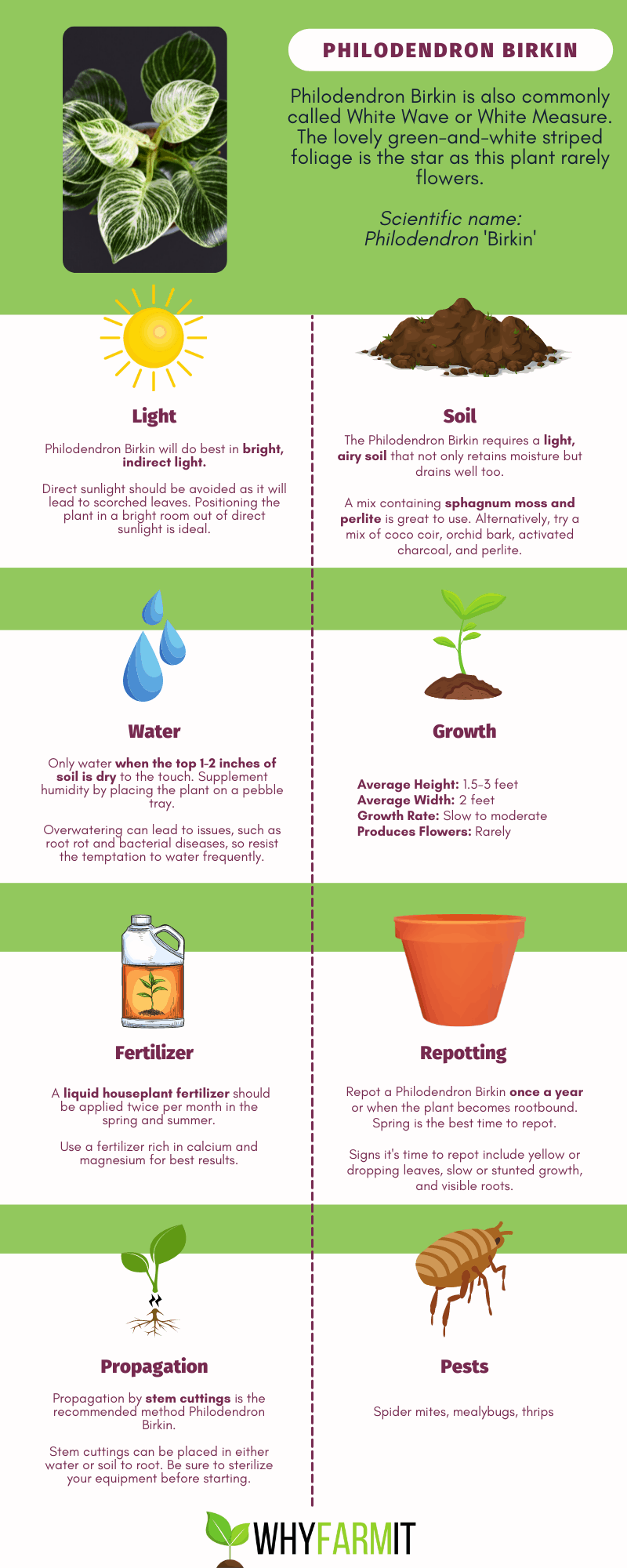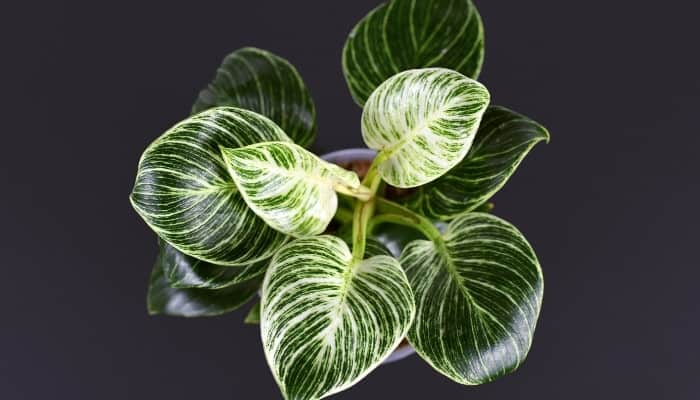The Philodendron ‘Birkin’ or ‘White Wave’, notable for its unique leaf designs marked by whimsical white stripes, belongs to the Araceae family.
This variegated Philodendron produces heart-shaped leaves in various shades, from deep green to light green.
Native to Brazil’s warm and steamy jungles, this tropical plant is quite happy to make its home in offices and plant lovers’ homes across the globe.
How do you care for Philodendron ‘Birkin’? Philodendron Birkin will do best with a rich, light, airy soil; plenty of bright, indirect light; 75-85℉ temperatures; and 60-70% humidity. Water thoroughly when the top few inches of the soil is dry, and during the growing season, feed with a houseplant fertilizer rich in calcium and magnesium.
Caring for Philodendron Birkin: Basic Guidelines
The table above summarizes the different sections we will cover in this guide to help you provide the proper nutrition and care required to keep your Philodendron Birkin healthy.
Read on to learn everything you need to know about this compact arum.
Complete Care Guide for Philodendron Birkin
The comprehensive guide that follows will provide you with the knowledge necessary to maintain a strong and flourishing Philodendron ‘Birkin’.
The helpful hints and frequently asked questions sections target key tips and answers to questions that Philodendron owners often pose, so be sure to read to the end.
Philodendron Birkin at a Glance
- Scientific Name: Philodendron ‘Birkin’
- Plant Type: Tropical
- Average Height: 1.5-3 feet (0.4-0.9 m )
- Width: 2 feet (60 cm)
- Growth Rate: Slow to moderate
- Produces Flowers: Rarely
- Common Pests: Spider mites, thrips
- Level of Care: Moderate
What To Do When You First Get Your Philodendron Birkin
Inspect the plant pot and ensure it has enough drainage holes for excess water to drain. This plant does not appreciate boggy soil.
Place the plant in a moderately warm, bright room away from direct sunlight and drafts.
We recommend positioning the plant pot on a pebble tray (like this sturdy tray with included rocks) filled with water to increase humidity around the plant as this plant enjoys high humidity levels.
Ideal Soil for Philodendron Birkin
The Philodendron ‘Birkin’ enjoys light, airy soil. However, the soil does need to retain moisture without drying out too fast.
Use a sphagnum peat moss-based soil with additional perlite mixed in for an excellent well-draining and moisture-retaining potting mix.
You can create an excellent potting mix using coco coir, orchid bark, activated charcoal, and perlite.
Perlite and orchid bark help with soil drainage, which is crucial for the health of the Philodendron ‘Birkin’.
Philodendron Birkin Water Requirements
Moist soil conditions are required for the Philodendron ‘Birkin’. Overwatering can harm your plant by causing root rot.
Check that the top 1-2 inches (2.5-5 cm) of soil is touch dry to before hauling out the watering can.
Philodendron Birkin Lighting Needs
Tall trees and vegetation naturally shade this plant in its native habitat. As a result, it enjoys lots of bright indirect light, but direct sunlight can scorch and bleach its foliage.
Ideal Temperature Range for Philodendron Birkin
The tropical Philodendron ‘Birkin’ is naturally heat-seeking and does well in temperatures that range from 75-85℉ (23-29℃) during the day and 65-75℉ (18-21℃) at night.
Unfortunately, this is not a frost-resistant plant, and it won’t do well in temperatures that drop below 50℉ (10℃).
Ideal Humidity Level for Philodendron Birkin
This plant thrives in warm and humid conditions. To maintain optimum growth and health, keep the humidity levels between 60-70%.
Best Location for Philodendron Birkin
When positioning the plant indoors, keep in mind the natural habitat of the plant. Copying this environment will provide the best results.
For example, bright kitchens and bathrooms are excellent rooms for this plant due to their high heat and humidity levels.
Alternatively, using a pebble tray under the plant and placing it in a bright room is also an option.
Philodendron Birkin Growth Habits
There is conflicting information that suggests this plant is both slow-growing and fast-growing.
However, with the right conditions and space, the Philodendron Birkin can grow to heights of 3 feet (0.9 m).
However, if grown indoors, pruning will prevent it from becoming too large for its growing area.
Fertilization Type & Schedule for Philodendron Birkin
The Philodendron ‘Birkin’ enjoys feeding and will produce large leaves if fed every other week during the growing season. Use a liquid fertilizer rich in calcium and magnesium.
Signs of Nutrient Deficiency
Leaves turn yellow and look wilted when nutrients are lacking. Check that the soil is draining well and the plant is receiving enough indirect light.
In addition, ensure the liquid fertilizer used contains the primary nutrients required – calcium and magnesium.
Pruning Philodendron Birkin
Pruning requirements are minimal as the Philodendron ‘Birkin’ is naturally compact and full looking.
However, the removal of dead and diseased leaves is recommended to maintain the health and beauty of the plant.
Does Philodendron Birkin Produce Flowers?
It’s rare for the Philodendron ‘Birkin’ to produce flowers. Some Philodendron plants only produce flowers at maturity, which can take between 15 and 16 years.
Is Philodendron Birkin Toxic?
The Philodendron ‘Birkin’ has leaves that contain calcium oxalate crystals that are toxic to pets and humans if swallowed.
Some side effects from these toxins can cause rashes, pain, inflammation, drooling, and loss of speech.
Philodendron Birkin Propagation
Philodendron ‘Birkin’ is easily propagated using stem cuttings. The cuttings can be grown in either water or soil, depending on your preference.
Cuttings are best taken in spring and summer when the plant is actively growing. Plants can be propagated at any age without having to reach maturity first.
Propagation of Philodendron Birkin With Stem Cuttings
This is the primary form of propagation when increasing the size of your Philodendron ‘Birkin’ family.
As this plant rarely flowers, propagation from seed is nearly impossible.
To propagate using stem cuttings, you will need a clean, sterilized pair of scissors, a clean jar, and some fresh warm water or a container of fresh soil.
Note that it’s essential to wear protective gloves when handling this plant as its leaves contain skin-irritating toxins.
1. Select a Healthy Plant and Cut a Stem Measuring 3 Inches in Length
Using the sterile scissors, snip a cutting just below a node. The cutting should be three to six inches long with two to four leaves.
You should be able to see tiny aerial roots sprouting just below the node.
2. Place the New Cutting Onto a Piece of Paper Towel
Allow the new cutting to dry for about an hour. This allows the stem to form callouses.
3. Dip the Cutting into Rooting Hormone Powder
Gently dip the cutting into the rooting powder and tap off the excess powder.
Then place it into a jar of clean, warm water or in a container filled with fresh soil. Note the soil should drain well.
4. Cover the Plant Container With a Clear Plastic Bag
To increase humidity levels, cover the container with a clear plastic bag.
This will create warm, humid conditions that are perfect for propagating a new Philodendron ‘Birkin’ plant.
5. Place the Container in a Warm Area
Position the container in a warm spot with access to bright but indirect light.
Open the bag regularly to provide fresh air circulation and check the soil remains consistently moist. Roots can take two to four weeks to develop.
6. Repot Fully Rooted Baby Philodendron Birkin Plant
Once the roots have developed, you can repot the cutting in a sphagnum peat moss-based soil.
Then, continue to care for your nursling plants by following the same guidelines recommended for parent plants.
Repotting Philodendron Birkin
Repotting is recommended every year for the Philodendron ‘Birkin’. However, this is only necessary if the plant has become rootbound.
If your plant requires repotting, it’s best to do this in the spring when it has entered its growing cycle.
When To Repot Philodendron Birkin
When you notice discolored leaves, soil that no longer retains moisture, or a noticeable reduction of growth, it is time to rejuvenate the plant with a slightly larger pot and fresh potting mix.
Signs That It’s Time To Repot
- Yellowing foliage
- Reduced growth
- Mature leaves drop off
- Roots visible above the soil
- Roots growing through the containers drainage holes
How To Repot Philodendron Birkin
The successful repotting of a Philodendron ‘Birkin’ requires the use of some essential tools: protective gloves, a new container, fresh potting mix, and water.
Always wear protective gloves when handling this plant as it is toxic and can cause skin irritation.
1. Select a Container 1-2 inches Bigger Than the Current Container
Using a large container can lead to overwatering and subsequent root rot.
2. Gently Remove the Plant From Its Container
Tip the plant out of its container, balancing the root ball in your hand.
If the roots have attached to the container sides, use a knife to dislodge them gently. Try to avoid breaking roots unnecessarily.
3. Loosen the Compacted Soil With Your Fingers
Using your fingers, loosen the soil surrounding the roots. Roots can become severely tangled and compacted, preventing the uptake of necessary nutrients.
4. Half Fill the New Container With Moist Potting Soil
Half fill the container with sphagnum peat moss-based soil.
Scoop out a fist-sized hollow in the soil and insert the root ball. Gently pack additional soil into the container until it is full.
5. Lightly Water the Plant and Check the Soil Is Draining Well
Water the plant to ensure the soil is draining well and not becoming waterlogged.
6. Position the Plant in a Warm Room in Bright Indirect Light
Repotting causes some stress for all plants, so be sure to provide warmth, humidity, and some extra attention to help your Philodendron ‘Birkin’ recover quickly.
Philodendron Birkin Common Problems & Solutions That Work
Philodendron Birkin Common Pests
All house plants struggle with pests at some stage of their leafy lives. This is not down to anything other than the fact that bugs happen!
As a good plant parent, you need to inspect your plants regularly to limit and eradicate infestations before they happen.
Spider Mites & Mealybugs
Signs of Trouble
Yellow or pale wilting foliage. Spider mites will leave wispy white webs attached to the leaves.
A common sign of mealybugs is a white cottony residue, sooty mold, and honeydew secretions.
Solution
Quarantine the plant from other household plants. Then, using a spray bottle or showerhead, spray the leaves to dislodge as many bugs as possible.
Next, spray the plant with a solution of neem oil, horticultural soap, or isopropyl alcohol. I’ve seen good results with this organic neem oil.
Prevention
Inspect the Philodendron ‘Birkin’ regularly for signs of pests. Bear in mind that pests, such as spider mites and mealybugs, tend to hide on the underside of leaves and along the stems.
Thrips
Signs of Trouble
Drooping leaves with black and dark patches.
Solution
Isolate the plant and remove damaged foliage. Take a soft sponge dipped in isopropyl alcohol and clean the leaves.
Prevention
Regularly inspect the Philodendron ‘Birkin’ for pests, paying close attention to the leaves and stems.
Once a month, clean the leaves and stems with a diluted neem oil solution to keep these pests away.
Philodendron Birkin Common Diseases
The Philodendron ‘Birkin’ is susceptible to diseases caused by overwatering. Fungal and bacterial infections spread quickly in warm, wet conditions.
A good preventive for overwatering is to use a watering spike (check out these hand-blown glass globe spikes) or self-watering plant pots.
Xanthomonas & Erwinia
Signs of Trouble
Both Xanthomonas and Erwinia are forms of bacterial infection.
Xanthomonas presents as black wet-looking spots with yellow rings on the leaves. Erwinia shows up as small dark spots that spread quickly and cause the leaves to wilt and die.
Solution
Isolate the infected plant, and trim off all infected foliage. Dispose of diseased leaves away from healthy plants.
Repot the plant in fresh potting mix to help revive the plant. The use of a copper spray may be helpful to control the disease. I recommend this organic option.
Prevention
Water the Philodendron when soil is semi-dry. Check the top layer of soil is touch dry to about 1-2 inches (2.5-5 cm) between watering sessions.
Other Common Problems
The truth is that overwatering or not watering enough are the main reasons for the problems plant parents face when caring for the Philodendron ‘Birkin’.
Yellow Leaves
Signs of Trouble
Yellowing leaves.
Solution
Check the soil is not waterlogged and reduce watering sessions if the soil feels soggy to the touch. Also, ensure the plant is not in direct sunlight or suffering from cold exposure.
Prevention
Water the plant only when the top layers of soil are touch dry.
Position the plant in bright indirect light, and ensure that the Philodendron ‘Birkin’ is not exposed to temperatures below 50℉ (10℃).
Brown Leaf Tips and Edges
Signs of Trouble
Brown leaf tips or edges. Brown patches feel papery to the touch.
Solution
Ensure the plant has not become dehydrated or waterlogged. Check the soil is moist, and increase humidity levels using a pebble tray or humidifier.
Position the plant so it is not exposed to excessive heat and direct sunlight.
Prevention
Keep the plant in a warm, humid environment with access to bright indirect light. Use a sheer curtain or blind to deflect direct sunlight.
Follow the guidance on when to water, and avoid allowing the soil to become overly dry.
Philodendron Birkin Common Questions

Is the Philodendron ‘Birkin’ Rare?
Initially, this plant was considered rare as it originates from some pretty hard-to-reach locations. This, coupled with its unique variegation, placed it on the rare plant list.
However, due to the increased use of tissue propagation, they are now easily purchased from many local nurseries.
How Much Is a Philodendron Birkin?
You can expect to pay approximately $9 for the Philodendron ‘Birkin’.
This price is relatively low compared to recent years when the plant price was more than $60 due to the plant’s rarity.
Can a Philodendron Birkin Revert?
The Philodendron ‘Birkin’ is considered genetically unstable, which may cause it to revert.
However, if the plant develops one or two green leaves, this is normal and not a sign of reverting. A healthy plant should produce a mix of green and striped leaves.
Why Is My Philodendron Birkin All Green?
This could be a sign that the Philodendron ‘Birkin’ has reverted. If you notice the plant has started to revert, try increasing its exposure to indirect light.
The more indirect light your plant receives, the brighter the white pinstripes become on the leaves.
In addition, prune the plain green leaves to encourage new leaves to regain their pinstripes.
How Do You Make a Philodendron Bushy?
This is a naturally bushy plant. To maintain this bushy appearance, prune the Philodendron ‘Birkin’ twice a year.
Do Philodendron Birkin Climb?
This variety of Philodendron is not a climber and not easily trained to grow on a trellis or fence.
It can support its own weight as it grows upright, so it does not seek support from its surroundings.
How Long Does It Take for a Philodendron ‘Birkin’ To Mature?
It can take between 15 and 16 years for the Philodendron ‘Birkin’ to mature.
Is Philodendron ‘White Measure’ the Same as ‘Birkin’?
The Philodendron ‘White Measure’ is also called the ‘Birkin’. This plant is known for its unique variegation of green leaves with white pinstripes.
How Long Will a Philodendron ‘White Wave’ Live?
To encourage longevity, provide the plant with well-draining, nutrient-rich soil.
In addition, providing the correct heating, lighting, and watering requirements will prevent the plant from an untimely demise.
5 Key Tips for Success With Philodendron Birkin

- Use a hygrometer to measure humidity levels, and ensure they remain at 60-70%.
- Ensure the plant receives sufficient indirect light. Using a grow light can provide the correct light levels for the Philodendron ‘Birkin’ and increase leaf size.
- Use a liquid fertilizer that is high in calcium and magnesium during the growing season.
- Self-watering containers or a watering spike can help prevent overwatering.
- Keep the plant in the kitchen or bathroom to help maintain warmth and humidity levels.
Conclusion
This tropical diva requires a bit of extra attention and care, especially when providing the correct soil moisture levels.
However, by following the basic guidelines that outline the day-to-day requirements and using our handy tips and suggestions, this gorgeous Araceae will keep surprising you with its unique leaf patterns.


